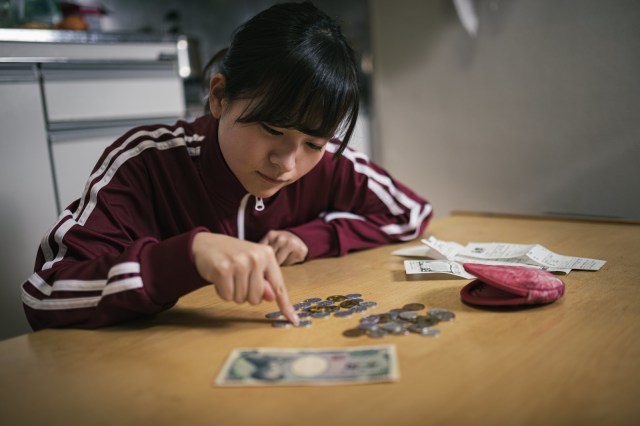
Students are also asked if they’re satisfied with the amount that they have to spend.
Remember back to the simple days of your youth when you got money for doing absolutely nothing but existing? It’s seriously a shame that adulthood doesn’t come with a free monthly allowance clause.
Since the amount of allowance money that parents give to their children varies from family to family (as does New Year’s otoshidama gift money), Japanese human resources company Recruit was curious to learn what amounts families are shelling out for their high school-aged children these days. Therefore, it implemented an online survey in May which asked 1,000 high school students (273 males and 727 females) around the country who receive a monthly allowance how much they receive, when they receive it, and if they’re satisfied with the amount. Before you ask, “But why don’t they just get a part-time job?” remember that part-time jobs may not be as common for Japanese high school students as they are for students in other countries, with the pressures of university entrance exams, cram school at night, and “not-mandatory-but-mandatory” club activities taking up lots of time.
OK, let’s dive in to the survey results. A Japanese high school student’s typical monthly allowance comes out to be an average of 5,582 yen (US$41.28–but remember, the yen is currently at its lowest value against the US dollar in 20 years). For reference, that’s just under the cost of the Pokémon Legends: Arceus Nintendo Switch game, which retails for 6,578 yen.
▼ If you see Meiji-era scholar Yukichi Fukuzawa peeking out at you from your monthly allowance, you’re a lucky high school student indeed. He appears on Japan’s 10,000-yen banknote.
Broken down by year, first-year high school students reported an average of 5,013 yen, second-year high school students an average of 5,518 yen, and third-year high school students an average of 5,759 yen. That’s a 14.9 percent increase over three years of high school. In terms of reasons for why it increases, 41.4 percent said that it goes up when they begin a new school, 39.1 percent said when moving on to the next grade, 14.2 percent said when they do well in their studies, 11.9 percent said when they negotiate a raise, and 10.5 percent said on their birthday.
In regards to when they receive their allowance, 64.9 percent of students responded that they receive a fixed amount every month. Meanwhile, 36.6 percent responded that they receive it when it’s necessary and 9.1 percent responded that they receive it in exchange for doing chores or getting good grades.
▼ Spare sushi change–We wonder if an important reason like “studying the differences between conveyor belt sushi chains” hamburger steak sushi ” would qualify as “necessary”…?
So are the high school students themselves pleased with the amount of allowance that they receive? Overall, yes, since 62.9 percent stated that they’re satisfied while 37.1 percent are dissatisfied. However, among those who feel dissatisfied, about 60 percent also have no plans to negotiate for a raise because they feel happy to be getting an allowance at all.
Now that we know a bit more about the numbers, we’d be curious to see whether students would prefer to spend their allowance on eating quadruple cheeseburgers or putting it in the bank. We hope that they know the only appropriate choice.
Source: Livedoor News via My Game News Flash
Featured image: Pakutaso
Images: Pakutaso (1, 2)
● Want to hear about SoraNews24’s latest articles as soon as they’re published? Follow us on Facebook and Twitter!



 Flush with New Year’s present cash, Japanese kids can now look forward to…saving it
Flush with New Year’s present cash, Japanese kids can now look forward to…saving it Survey suggests that almost 40 percent of Japanese men are reluctant to eat alone in public
Survey suggests that almost 40 percent of Japanese men are reluctant to eat alone in public How often do Japanese high school kids watch anime, and do boys and girls watch the same series?
How often do Japanese high school kids watch anime, and do boys and girls watch the same series? Survey responds to the most important factors when deciding which izakaya to go to
Survey responds to the most important factors when deciding which izakaya to go to Over 50 percent of single Japanese women in their 20s struggle to make ends meet, survey says
Over 50 percent of single Japanese women in their 20s struggle to make ends meet, survey says Foreigner’s request for help in Tokyo makes us sad for the state of society
Foreigner’s request for help in Tokyo makes us sad for the state of society Seaside scenery, history, and so many desserts on Yokohama’s Akai Kutsu【Japan Loop Buses】
Seaside scenery, history, and so many desserts on Yokohama’s Akai Kutsu【Japan Loop Buses】 Japanese city loses residents’ personal data, which was on paper being transported on a windy day
Japanese city loses residents’ personal data, which was on paper being transported on a windy day Japan’s summertime towelket pillowcases are even better with the addition of Ghibli stars【Photos】
Japan’s summertime towelket pillowcases are even better with the addition of Ghibli stars【Photos】 Should you add tartar sauce to Japanese curry rice? CoCo Ichi makes diners an unusual offer
Should you add tartar sauce to Japanese curry rice? CoCo Ichi makes diners an unusual offer Smash Bros. director Sakurai stabs Kirby in the face, has delicious justification for it
Smash Bros. director Sakurai stabs Kirby in the face, has delicious justification for it The results are in! One Piece World Top 100 characters chosen in global poll
The results are in! One Piece World Top 100 characters chosen in global poll Osaka governor suggests lowering voting age to 0 to curb population decline
Osaka governor suggests lowering voting age to 0 to curb population decline Japanese ramen restaurants under pressure from new yen banknotes
Japanese ramen restaurants under pressure from new yen banknotes Cardcaptor Sakura Chinese Cafe opens in Tokyo, coming to other cities with special merch【Pics】
Cardcaptor Sakura Chinese Cafe opens in Tokyo, coming to other cities with special merch【Pics】 McDonald’s new Happy Meals offer up cute and practical Sanrio lifestyle goods
McDonald’s new Happy Meals offer up cute and practical Sanrio lifestyle goods French Fries Bread in Tokyo’s Shibuya becomes a hit on social media
French Fries Bread in Tokyo’s Shibuya becomes a hit on social media Studio Ghibli releases new action figures featuring Nausicaä of the Valley of the Wind characters
Studio Ghibli releases new action figures featuring Nausicaä of the Valley of the Wind characters Red light district sushi restaurant in Tokyo shows us just how wrong we were about it
Red light district sushi restaurant in Tokyo shows us just how wrong we were about it New private rooms on Tokaido Shinkansen change the way we travel from Tokyo to Kyoto
New private rooms on Tokaido Shinkansen change the way we travel from Tokyo to Kyoto Tokyo Tsukiji fish market site to be redeveloped with 50,000-seat stadium, hotel, shopping center
Tokyo Tsukiji fish market site to be redeveloped with 50,000-seat stadium, hotel, shopping center Beautiful Ghibli sealing wax kits let you create accessories and elegant letter decorations【Pics】
Beautiful Ghibli sealing wax kits let you create accessories and elegant letter decorations【Pics】 Studio Ghibli releases Kiki’s Delivery Service chocolate cake pouches in Japan
Studio Ghibli releases Kiki’s Delivery Service chocolate cake pouches in Japan New definition of “Japanese whiskey” goes into effect to prevent fakes from fooling overseas buyers
New definition of “Japanese whiskey” goes into effect to prevent fakes from fooling overseas buyers Our Japanese reporter visits Costco in the U.S., finds super American and very Japanese things
Our Japanese reporter visits Costco in the U.S., finds super American and very Japanese things All-you-can-drink Starbucks and amazing views part of Tokyo’s new 170 meter-high sky lounge
All-you-can-drink Starbucks and amazing views part of Tokyo’s new 170 meter-high sky lounge More foreign tourists than ever before in history visited Japan last month
More foreign tourists than ever before in history visited Japan last month New Pokémon cakes let you eat your way through Pikachu and all the Eevee evolutions
New Pokémon cakes let you eat your way through Pikachu and all the Eevee evolutions Disney princesses get official manga makeovers for Manga Princess Cafe opening in Tokyo
Disney princesses get official manga makeovers for Manga Princess Cafe opening in Tokyo Sales of Japan’s most convenient train ticket/shopping payment cards suspended indefinitely
Sales of Japan’s most convenient train ticket/shopping payment cards suspended indefinitely Sold-out Studio Ghibli desktop humidifiers are back so Totoro can help you through the dry season
Sold-out Studio Ghibli desktop humidifiers are back so Totoro can help you through the dry season Japanese government to make first change to romanization spelling rules since the 1950s
Japanese government to make first change to romanization spelling rules since the 1950s Ghibli founders Toshio Suzuki and Hayao Miyazaki contribute to Japanese whisky Totoro label design
Ghibli founders Toshio Suzuki and Hayao Miyazaki contribute to Japanese whisky Totoro label design Doraemon found buried at sea as scene from 1993 anime becomes real life【Photos】
Doraemon found buried at sea as scene from 1993 anime becomes real life【Photos】 Tokyo’s most famous Starbucks is closed
Tokyo’s most famous Starbucks is closed One Piece characters’ nationalities revealed, but fans have mixed opinions
One Piece characters’ nationalities revealed, but fans have mixed opinions We asked a Uniqlo employee what four things we should buy and their suggestions didn’t disappoint
We asked a Uniqlo employee what four things we should buy and their suggestions didn’t disappoint Princesses, fruits, and blacksmiths: Study reveals the 30 most unusual family names in Japan
Princesses, fruits, and blacksmiths: Study reveals the 30 most unusual family names in Japan Why you probably won’t get home-made Valentine chocolate and love confession from a Japanese girl
Why you probably won’t get home-made Valentine chocolate and love confession from a Japanese girl Majority of younger Japanese people in survey respect less than 30 percent of their old coworkers
Majority of younger Japanese people in survey respect less than 30 percent of their old coworkers Japanese girls reveal who they really give most Valentine’s chocolates to, and it’s not boys
Japanese girls reveal who they really give most Valentine’s chocolates to, and it’s not boys Young Japanese adults in survey don’t even want to live to Japan’s average life expectancy
Young Japanese adults in survey don’t even want to live to Japan’s average life expectancy Rate of young Japanese people who want to get married someday drops to lowest ever in survey
Rate of young Japanese people who want to get married someday drops to lowest ever in survey Japanese college students share four ways anime high school is different from real high school
Japanese college students share four ways anime high school is different from real high school Kyoto families angered by new policy forcing high school students to buy tablets at own expense
Kyoto families angered by new policy forcing high school students to buy tablets at own expense What do Japanese kids want to be when they grow up? For 30 percent of boys, YouTubers, survey says
What do Japanese kids want to be when they grow up? For 30 percent of boys, YouTubers, survey says What’s the minimum amount of money Japanese women want their husbands to earn? Survey investigates
What’s the minimum amount of money Japanese women want their husbands to earn? Survey investigates Japanese high school adds culottes to uniforms to better accommodate gender diversity
Japanese high school adds culottes to uniforms to better accommodate gender diversity Japan’s legal age of adulthood dropping by two years, but do teens understand what that means?
Japan’s legal age of adulthood dropping by two years, but do teens understand what that means? Over 30 percent of surveyed Japanese managers feel intense stress from working with foreigners
Over 30 percent of surveyed Japanese managers feel intense stress from working with foreigners Survey says Japan is deeply dissatisfied in bedroom, prefers eating to getting it on
Survey says Japan is deeply dissatisfied in bedroom, prefers eating to getting it on Petition to allow students to choose what they wear to school gathers almost 19,000 signatures
Petition to allow students to choose what they wear to school gathers almost 19,000 signatures Teacher says Japanese schools’ mandatory extracurricular activity rules don’t benefit students
Teacher says Japanese schools’ mandatory extracurricular activity rules don’t benefit students
Leave a Reply